Magnets with a small bore or no bore have reached 16 T in the US and recently at CERN. Modeling indicates that this is close to the “practical” limit for currently available high performance Nb3Sn wire. The remaining challenge is to realize this potential in accelerator quality magnets: both in magnets with small aperture, typical of high-energy colliders, and in magnets with larger aperture, to provide background field for HTS inserts. We aim to demonstrate the feasibility of a magnet with a bore field of 16 T (at 90% of the conductor limit) with a bore greater than or equal to 50 mm, with two complementary approaches. One approach is building a reference design based on the well-understood cosine-theta geometry traditionally used for accelerator magnets; the other approach is aggressively investigating innovative designs that may prove to have better performance at a lower cost.
Reference design based on the cosine-theta concept
The last high-field record Nb3Sn cosine-theta magnet was LBNL’s D20, which reached 13.5 T at 1.9 K in 1997.1 Since then, conductor critical current density (Jc) has more than doubled, and a mechanical support structure customized for strain-sensitive superconductors such as Nb3Sn has been developed and optimized.2 ,3 A new cosine-theta design incorporating the latest superconductor and structure improvements should attain 16 T with a 50 mm aperture and will serve as a reference design for the program. This may be thought of as an apex implementation of the presently mainstream approach.
 Click for larger version Cross section of 15-T cosine-theta dipole. |
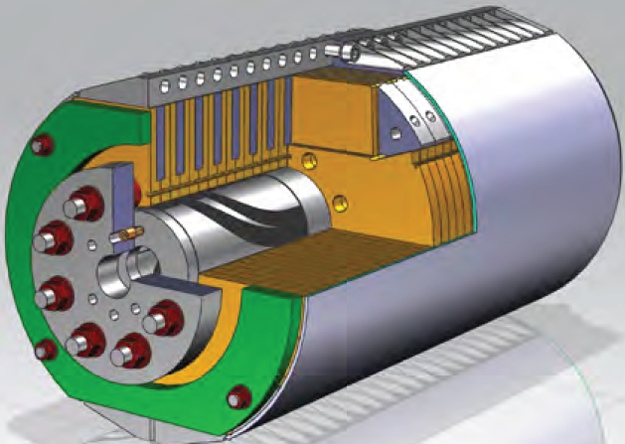 Click for larger version Support structure for 15-T dipole. |
This goal is supported by a 2013 DOE review of high-energy physics, which stated in its report, “Recent efforts toward high field magnets have not been as successful as expected. Despite a doubling of the critical current density in Nb3Sn, recent test magnets with a gap have not improved upon the earlier D20 field results of about 14 T… Given the lack of progress in increasing the bore field, it may be worthwhile to consider designing, fabricating, and testing a cos-theta magnet like D20 but using the recent advances in 2D/3D design techniques and the best available Nb3Sn strand to see if there are any fundamental limitations to the present approach.” |
||
A technical baseline design based on an optimized cosine-theta geometry that addresses this comment has been developed utilizing existing expertise, tooling and infrastructure available at FNAL.4 ,5 The proposed 4-layer, 60 mm aperture dipole will explore the target field and force range and serve as a technical and cost basis for comparison with new concepts. It also offers an opportunity for program integration, particularly in the area of support structure design, and for exploration of various support structures. This is the most cost effective way to get into a field range that would exceed the LBNL D20 dipole built almost 20 years ago. A successful series of magnets will provide a platform for performance improvement by integrating the outcomes of the Technology Development program; the integration will then be followed by value engineering studies. In parallel, the program will develop a cos-theta design that explores the ultimate limit of Nb3Sn in this geometry.
Innovative designs
In parallel with the traditional and well-understood baseline program of cosine-theta magnets, we will explore innovative designs that include stress management, initially with the Canted Cosine-Theta approach, that strive to address accumulation of Lorentz forces and resulting high mechanical stresses, and that have potential for reducing the cost per tesla-meter. Both stress management and cost per T-m are dominant issues in high-field magnets.
A critical aspect of the program is to aggressively investigate innovative new design concepts that may prove to have better performance at a lower cost per T-m. Initially, an alternative magnet design, the CCT concept, will be investigated for high-field accelerator magnets.6 ,7 The main motivation is in the area of mechanical stresses: preliminary calculations show dramatic reduction in azimuthal stresses, effectively eliminating these stresses as limitations in the magnet design. If this proves to be the case, the concept will allow for conductor grading and for the implementation of HTS materials for very high-field CCT magnet designs. Since this design is quite different from previous geometries, the first phase will focus on a 2-layer design with a nominal bore field of 10 T and 90 mm aperture in order to understand performance drivers and establish fabrication techniques. Once deemed successful, the next steps would lead to an 8-layer, 16 T dipole with 90 mm aperture. The 90 mm bore size allows these magnets to potentially serve for testing of HTS inserts fairly early in the program.
When sufficient experience has been gained through this program and the parallel technology development component, there will be a down-select or branch point to an alternative design path.
Development Milestones
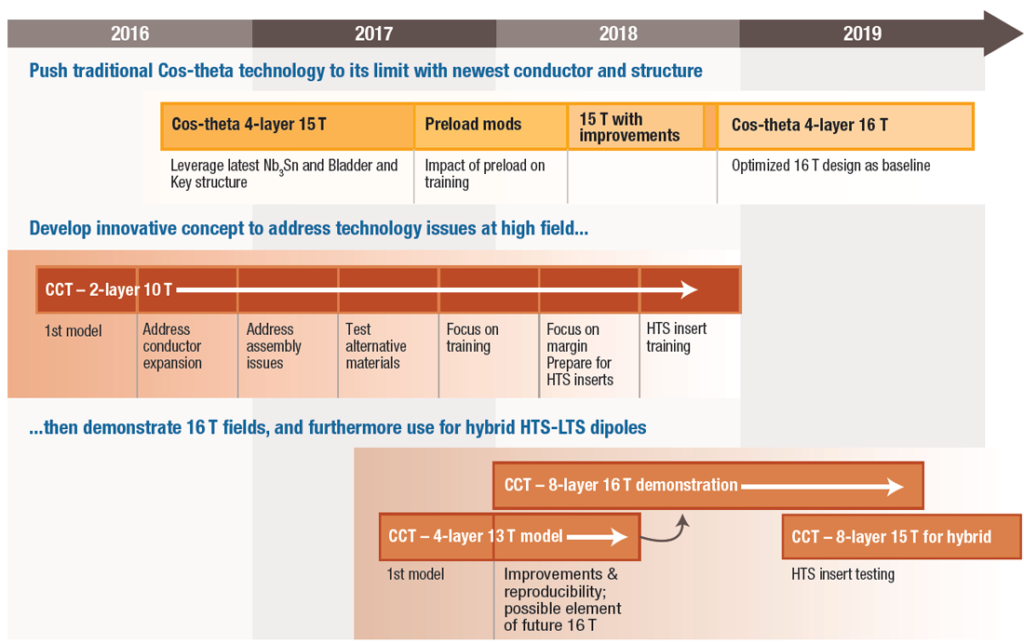
Overview of the Nb3Sn milestone plan, highlighting cos(θ) reference magnet development (top) and the innovation route with Canted Cosine-Theta (CCT): ~10 T subscale magnet development (middle), followed by 16 T model magnets (bottom).
Meet the team leads
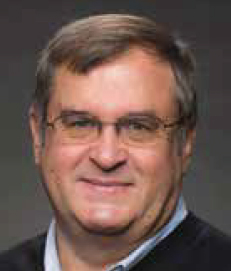
Alexander V. (Sasha) Zlobin, Fermilab |
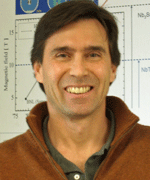
GianLuca Sabbi, LBNL |
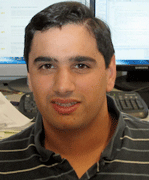
Diego Arbelaez, LBNL |
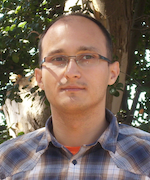
Mariusz Juchno, LBNL |
|||||
References
1 D. Dell’Orco, R. Scanlan, and C.E. Taylor, “Design of the Nb3Sn Dipole D20,” IEEE Transactions on Applied Superconductivity 3, 1 (February 1993), pp. 82-86.
2 R.R. Hafalia, P.A. Bish, S. Caspi, D.R. Dietderich, S.A. Gourlay, R. Hannaford, A.F. Lietzke, N. Liggins, A.D. McInturff, G.L. Sabbi, R.M. Scanlan, J. O’Neill, and J.H. Swanson, “A New Support Structure for High Field Magnets,” in Proceedings of MT-17, the 17th International Conference on Magnet Technology (Geneva, Switzerland, September 24 – 28, 2001), IEEE Transactions on Applied Superconductivity 12, 1 (March 2002), pp. 47-50.
3 A.F. Lietzke, S. Bartlett, P.A. Bish, S. Caspi, L. Chiesa, D.R Dietderich, P. Ferracin, M. Goli, S.A. Gourlay, R.R. Hafalia, C.R. Hannaford, H. Higley, N.L. Liggins, S. Mattafirri, A. McInturff, M. Nyman, G. Sabbi, R.M. Scanlan, J. Swanson, “Test Results for HD-1, a 16 Tesla Nb3Sn Dipole Magnet,” IEEE Transactions on Applied Superconductivity 14, 2 (June 2004), pp. 345-348.
4 A.V. Zlobin, N. Andreev, E. Barzi, V.V. Kashikhin, and I. Novitski, “Design Concept and Parameters of a 15 T Nb Sn Dipole Demonstrator for a 100 TeV Hadron Collider,” in Proceedings of the 2015 International Particle Accelerator Conference (JACoW, 2015), WEPTY041.
5 I. Novitski, N. Andreev, E. Barzi, J. Carmichael, V.V. Kashikhin, D. Turrioni, M. Yu, and A.V. Zlobin, “Development of a 15 T Nb Sn Accelerator Dipole Demonstrator at Fermilab,” IEEE Transactions on Applied Superconductivity 26, 3 (June 2016), p. 4003006.
6 L. Brouwer, D. Arbalaez, S. Caspi, H. Felice, S. Prestemon, and E. Rochepault, “Structural Design and Analysis of Canted “Cosine Theta” Dipoles,” in Proceedings of MT-23, the 23rd International Conference on Magnet Technology (Boston, Massachusetts, US, 14-19 July 2013), IEEE Transactions on Applied Superconductivity 24, 3 (June 2014), p. 6620990.
7 S. Caspi, F. Borgnolutti, L. Brouwer, D. Cheng, D.R. Dietderich, H. Felice, A. Godeke, R. Hafalia, M. Martchevskii, S. Prestemon, E. Rochepault, C. Swenson, and X. Wang, “Canted-Cosine – Theta Magnet (CCT) — A Concept for High Field Accelerator Magnets,” in Proceedings of MT-23, the 23rd International Conference on Magnet Technology (Boston, Massachusetts, US, 14-19 July 2013), IEEE Transactions on Applied Superconductivity 24, 3 (June 2014), p. 6621012.
